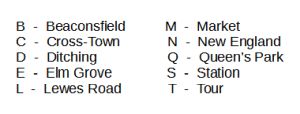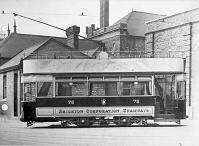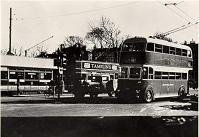


 Schemes for tramways were suggested in 1864, 1879 and 1883, but the corporation's electric tramway system, authorised under the Brighton Corporation Act of 1900, commenced service on 25 November 1901 when the first car was ceremonially driven by the mayor, John Stafford, from the initial terminus at the southern end of Victoria Gardens along Lewes Road to Preston Barracks. Fares were charged initially at one penny for any distance.
The 9.5-mile system, completed by July 1904, was operated in a number of routes each known by the initial letter of a road or location along it, viz:
Schemes for tramways were suggested in 1864, 1879 and 1883, but the corporation's electric tramway system, authorised under the Brighton Corporation Act of 1900, commenced service on 25 November 1901 when the first car was ceremonially driven by the mayor, John Stafford, from the initial terminus at the southern end of Victoria Gardens along Lewes Road to Preston Barracks. Fares were charged initially at one penny for any distance.
The 9.5-mile system, completed by July 1904, was operated in a number of routes each known by the initial letter of a road or location along it, viz:

Special services were operated on race days, and also to Dyke Road when Brighton and Hove Albion played at home. Frequencies of four to five minutes were operated, and typical journey times from the Old Steine were: Brighton Station (8 minutes); Fiveways (18); Preston Barracks (15); Race Hill (18); Rock Gardens (27); and Tivoli Crescent (20).
 Fifty cars were initially purchased for the system, and 116 replacements were built over the years at the corporation's tramway depot in Lewes Road. All were four-wheeled, open-top, double-decker vehicles in a burgundy-and-cream livery, operating from trolley wires at 550 volts d.c. with 40-50 b.h.p. engines. The cars, several of which were illuminated with coloured bulbs, were six feet wide, nearly thirty feet long, and ran on a gauge of 3 ft 6 ins. The tracks were laid in the centres of the roadways, and the road surface was then laid with wooden blocks to bring it up to the same level. Tram stops were marked by studs in the middle of the road.
Fifty cars were initially purchased for the system, and 116 replacements were built over the years at the corporation's tramway depot in Lewes Road. All were four-wheeled, open-top, double-decker vehicles in a burgundy-and-cream livery, operating from trolley wires at 550 volts d.c. with 40-50 b.h.p. engines. The cars, several of which were illuminated with coloured bulbs, were six feet wide, nearly thirty feet long, and ran on a gauge of 3 ft 6 ins. The tracks were laid in the centres of the roadways, and the road surface was then laid with wooden blocks to bring it up to the same level. Tram stops were marked by studs in the middle of the road.
 The increasing suburban development of the 1930s, combined with the lack of flexibility of the tramway system, prompted the corporation to opt for a new network of both trolley- and motor-buses. Tram routes were consequently withdrawn and replaced by buses from 26 April 1939 until the last Brighton tram ran from Upper Rock Gardens to the Old Steine at 2 a.m. on 1 September 1939, bringing to an end thirty-eight years of almost accident-free service. An estimated 52 million miles had been run, 629 million passengers carried, and a profit of £54,000 made by the Brighton trams.
The increasing suburban development of the 1930s, combined with the lack of flexibility of the tramway system, prompted the corporation to opt for a new network of both trolley- and motor-buses. Tram routes were consequently withdrawn and replaced by buses from 26 April 1939 until the last Brighton tram ran from Upper Rock Gardens to the Old Steine at 2 a.m. on 1 September 1939, bringing to an end thirty-eight years of almost accident-free service. An estimated 52 million miles had been run, 629 million passengers carried, and a profit of £54,000 made by the Brighton trams.
The main relics of the tramways are the shelters in Ditchling Road (Florence Place), Queen's Park Road (Pepper-Box), and Dyke Road (reservoir); another has been used for the Aquarium Station of Volk's Railway, one may be found at the Stanmer Rural Museum, and two more have been removed to the Chalkpits Museum at Amberley. The tramway depot in Lewes Road is now the depot of Brighton Buses, but it retains windows etched with the words 'Brighton Corporation Tramways'. At the corner of Dyke Road and the Upper Drive is a standard that formerly supported the tram supply wires; it bears the initials 'BCT' and the borough arms.
Reproduced with permission from the Encyclopaedia of Brighton by Tim Carder, 1990
(c) Brighton Tram 53 Society, 2025